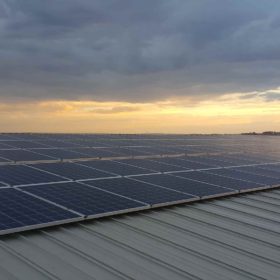
Australian scientists have identified seven methods to prevent PV losses when overvoltage-induced inverter disconnections occur. The methods include battery storage, reactive power inverters, export limits, distribution static synchronous compensators, the replacement of old conductors in power grids, load reconfiguration, and dynamic voltage restoration.
Scientists at the University of South Australia have identified a series of strategies that can be implemented to prevent solar power losses when overvoltage-induced inverter disconnections occur, due to voltage limit violations.
The research group said on-load tap changers (OLTC) and shunt reactors – two conventional technologies that are used to address the overvoltage issue – are not particularly effective for PV induced overvoltages, due to the intermittent nature of solar power itself. OLTCs are used to regulate power transformers in electrical energy networks and industrial applications, by enabling voltage regulation and phase shifting by varying the transformer ratio under load without interruption. Shunt reactors are applied to high-voltage power networks to stabilize the voltage during load variations.
Seven more technologies can be used in conjunction with the existing solutions. They include battery storage, inverters that can provide reactive power, export limits, distribution static synchronous compensators, the replacement of old conductors in power grids with bigger ones, load reconfiguration, and dynamic voltage restoration (DVR).
Batteries and inverters
The first of the proposed solutions is considered very effective, especially if implemented with proper sizing, siting and energy management. Current storage costs, however, are identified as the main barrier to mainstream deployment in the short term.
“However, recent trends show a reduction in battery costs and this trend is expected to continue,” the researchers said.
Countries such as Germany and Australia have introduced rules in recent years to allow inverters to provide reactive power support. “However, enabling this mode either reduces active power generation or increases the size of the inverter,” the scientists said.
This solution, which is considered a valid option for medium-voltage grids, is considered less effective for low-voltage networks. In such grids, reactive power variations have a relatively limited impact on voltage.
“Therefore, solar inverters aren’t highly effective in reducing the PV curtailment issue,” the group concluded, adding that they are only effective in reducing PV curtailment if they are combined with storage.
Export limits
Applying a 5-kVA limit on single-phase inverters to restrict excessive reverse power flow is a measure that has been implemented by Australian utilities. However, this approach should define an export limit that can address the overvoltage problem without excessive levels of PV curtailment.
Distribution static synchronous compensators (DSTATCOM) are considered particularly effective during solar power generation peaks. The technology can provide continuous reactive power support, but it is not considered ideal for reactive power compensation.
Larger conductors
Larger conductors are one possible way to increase grid capacity and enable more solar power without voltage fluctuations. “Increasing the cross-sectional area of the conductors can reduce the voltage drops,” the researchers said. “However, this solution is costly.”
Defined as an approach than needs more research, the reconfiguration of PV installations could help to improve voltage profiles. “It will allow utilizing the network infrastructure more effectively without much additional infrastructure cost,” the scientists explained.
The last of the seven solutions – the use of a dynamic voltage restorer (DVR) – is considered a low-cost, small-sized and effective approach. The device is described as a power electronic controller relying on a voltage source inverter, a filter, and a capacitor as a storage unit.“It is basically a series compensator whose output is connected in series with the distribution feeder,” the researchers said. “It can regulate the voltage by injecting a voltage of required magnitude and phase angle into the feeder.”The solution is expected to become a viable option in the future, especially if combined with storage. “With the use of the battery the size of the DVR can also be reduced,” the scientists said.
Potential impacts
The researchers presented the seven technologies in “Effects of high solar photovoltaic penetration on distribution feeders and the economic impact,” which was recently published in Renewable and Sustainable Energy Reviews. They quantified the impacts of PV penetration in terms of reverse power flow, overvoltage and undervoltage events at a real 11 kV distribution feeder in South Australia, where the PV penetration level is around 21.72%.
They estimated maximum possible PV generation losses, as well as the resulting financial losses, related to inverter shutdowns triggered by overvoltage issues.
“At this level of penetration, the overvoltage events cause nearly a thousand ‘nominal voltage violation’ instances at the inverters leading to at least 625 MWh of PV generation loss due to inverter disconnections,” the scientists explained. “For the customers, this represents an annual financial loss of over $106,000 due to the loss of energy export revenue.”
Lắp đặt điện mặt trời Khải Minh Tech
https://ift.tt/2X7bF6x
0906633505
info.khaiminhtech@gmail.com
80/39 Trần Quang Diệu, Phường 14, Quận 3
Lắp đặt điện mặt trời Khải Minh Tech
https://ift.tt/2ZH4TRU
Không có nhận xét nào:
Đăng nhận xét